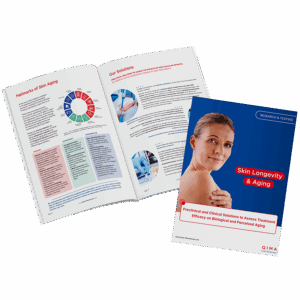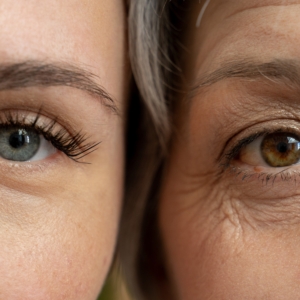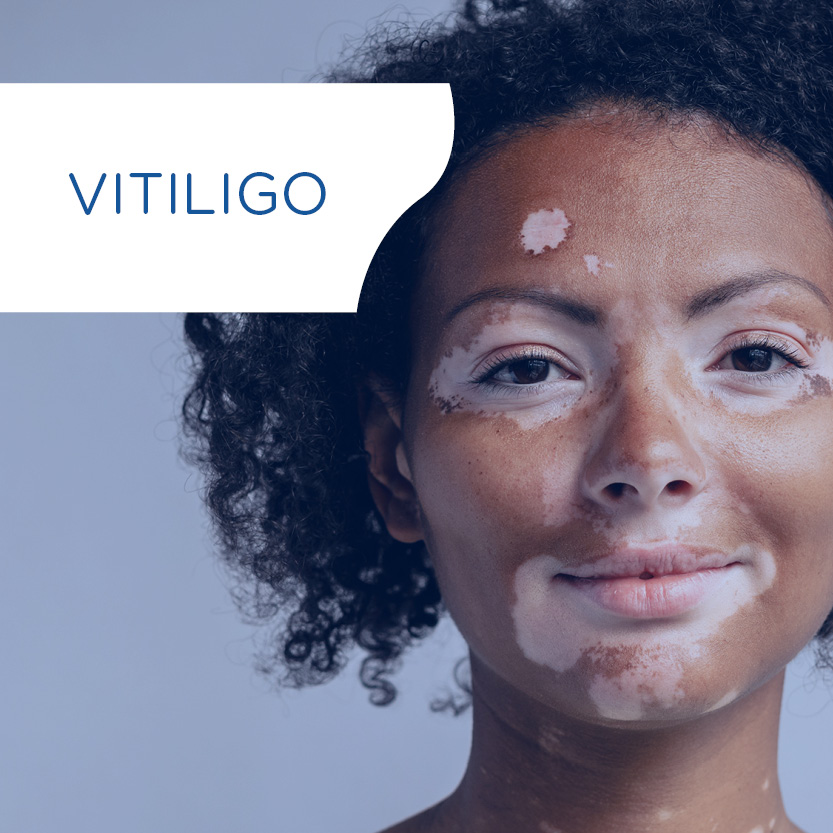Discover related blog articles
Once regarded as an inevitable and linear process, aging is now understood as a multifactorial phenomenon shaped by the interplay between intrinsic biological mechanisms and external environmental influences. The skin, as both a barrier and a mirror of internal health, embodies this complexity. By differentiating between chronological age, biological age, and perceived age, science is redefining how we assess and address skin aging, shifting from a focus on visible signs to the cellular and molecular processes that drive them.
A Broader Paradigm for Aging
Aging was long regarded as a linear and irreversible process measured only by chronological age. This view has been challenged by evidence that individuals of the same chronological age can differ significantly in their biological state and outward appearance. Advances in biomedical science show that aging reflects the cumulative impact of molecular and cellular damage, modulated by genetic, environmental, and lifestyle factors.
Population-level data confirm this shift in perspective. In long-lived populations, life expectancy has increased by roughly two years per decade, and recent cohorts often show improved health and lower biological age at the same chronological age compared to earlier generations. For example, in one cohort study, a 70-year-old in 2012 needed to look 2.3 years younger to be perceived the same age as a 70-year-old in 2002, a change that paralleled the 2.6-year gain in life expectancy at birth in Denmark over the same period.
This broader paradigm distinguishes three complementary dimensions:
- Chronological age: a fixed measure of time lived.
- Biological age: reflects the functional state of cells, tissues, and organs.
- Perceived age: describes how old someone appears or feels.
Unlike chronological age, both biological and perceived age are dynamic and modifiable, opening the door to targeted strategies that address not only visible signs but also the underlying biological processes that sustain skin health and vitality over time.
Toward a Multi-dimensional Approach for Skin Aging
For decades, cosmetic science primarily focused on perceived age, aiming to correct or mask visible signs such as wrinkles, uneven pigmentation and loss of firmness. While these approaches remain valuable, advances in skin biology and a deeper understanding of the molecular, cellular and systemic mechanisms underlying aging now provide a robust scientific foundation for intervention. This shift enables a transition from surface-level correction toward strategies that target the root causes of dysfunctions affecting skin health and vitality.
A multi-dimensional approach is therefore:
- More precise and targeted, focusing on specific biological pathways rather than generalized anti-aging actions.
- Inherently personalized, taking into account an individual’s genetic background and therefore their intrinsic aging trajectory.
- Attentive to extrinsic influences, assessing exposure to various components of the exposome: environmental factors, psychological stress, nutrition, sedentary lifestyle, and others, each of which exerts distinct effects on skin aging.
By mapping these intrinsic and extrinsic factors, it becomes possible to design interventions that act at multiple levels and time points, from prevention to repair. Yet, as in the adage “the map is not the territory”, any measurement or model of age remains a simplified representation. The complexity of skin aging requires both accurate assessment tools and an appreciation that no single metric can fully capture the underlying biological reality.
Download Our Skin Longevity & Aging Brochure

Unraveling the Biological Mechanisms of Aging
The 12 hallmarks of aging
Over the past decade, remarkable progress has been made in identifying the core biological processes that drive aging. A pivotal milestone was the framework of the “hallmarks of aging” proposed in 2013, initially listing nine fundamental mechanisms. This model was expanded in 2023 to twelve hallmarks, reflecting advances in our understanding of processes such as impaired autophagy, chronic inflammation, and age-related microbiome dysbiosis. Together, these hallmarks provide a structured map of the interconnected pathways that underlie aging at the molecular and cellular levels. For a detailed overview of these twelve hallmarks and how they relate to skin longevity, see Ageless Beauty: The Pursuit of Skin Longevity.
The 4 ageotypes
In parallel, more integrative approaches are emerging, revealing that aging is neither uniform nor linear. Longitudinal multi-omics profiling of healthy individuals, encompassing dimensions such as transcriptomics, proteomics, metabolomics, cytokines, and the microbiome, has enabled the identification of personalized aging trajectories, termed ageotypes, that reflect distinct molecular patterns of aging in systems such as immunity, metabolism, liver, or kidney function.
A nonlinear dynamic of human aging
Beyond identifying ageotypes, recent longitudinal multi-omics analyses of healthy individuals have revealed that aging unfolds through distinct, nonlinear phases rather than as a steady, continuous process. These studies highlight three critical inflection points in the human lifespan: around 34 years, with early metabolic changes; around 60 years, with coordinated shifts across immunity, metabolism, and cardiovascular function; and around 78 years, marked by a broader decline in multiple biological networks. These transitions likely represent periods of heightened vulnerability but also potential windows of opportunity for targeted interventions, paving the way for precision strategies that anticipate and counteract age-related decline before it becomes irreversible.
Altogether, advances in our understanding of aging, from universal hallmarks to individualized ageotypes and the identification of nonlinear biological transitions, are transforming skin aging research. This growing knowledge not only refines our conceptual framework but also lays the groundwork for the development of biomarkers, imaging technologies, and experimental models capable of assessing both biological and perceived aging with unprecedented precision. Building this bridge between fundamental biology and applied measurement is essential for evaluating and optimizing next-generation cosmetic interventions.
Assessing the Efficacy of Cosmetic Treatments: Innovations in Research on Biological and Perceived Aging
Biological aging
In skin research, biological aging refers to the progressive decline in the structure and function of cutaneous tissues driven by molecular, cellular, and systemic damage. Advances in the study of the hallmarks of aging have made it possible, in research settings, to assess biological age through multiple biomarkers, including telomere length, cellular senescence markers, or epigenetic profiling… While these measurements are typically conducted in vitro or ex vivo, their principles inform the design of cosmetic efficacy studies, guiding the selection of relevant endpoints for human testing.
In theory, each of the twelve hallmarks of aging could serve as a measurable target, offering a broad panel of biological readouts to monitor how skin is aging and how it responds to interventions. However, recent progress in the elucidation of molecular mechanisms has highlighted certain priorities, among which targeting cellular senescence stands out. Senescent keratinocytes and fibroblasts contribute to chronic low-grade inflammation (inflammaging) and to extracellular matrix degradation through the secretion of a complex pro-inflammatory profile known as the senescence-associated secretory phenotype (SASP). While the MICSE guidelines (Minimum Information for Cellular Senescence Experiments) provide a standardized framework for identifying and quantifying senescent cells in research settings, their invasive nature limits direct application in cosmetic clinical studies. Nevertheless, the underlying principles inspire the development of in vitro and ex vivo models capable of assessing active ingredients that modulate senescence or other hallmarks, thereby bridging fundamental biology with applied skincare research.
By integrating such biological endpoints into clinical or ex vivo protocols, cosmetic R&D can move beyond subjective claims to demonstrate mechanistic benefits, ensuring that interventions act not only on visible signs but also on the underlying processes that sustain skin vitality over time. Yet, because skin aging is ultimately perceived through visible changes, linking these biological insights to the way age is evaluated visually is essential. This is where perceived age assessment becomes a powerful complement, providing a direct, consumer-relevant readout that reflects the combined impact of intrinsic biology and extrinsic factors, and allowing a full alignment between molecular efficacy and real-world aesthetic outcomes.
Perceived aging
In cosmetic science, perceived age is defined as the apparent age attributed to an individual based on visual cues, most often from the skin of the face, but also influenced by hair, posture, and overall appearance. It is a complex, integrative parameter that reflects both intrinsic biological aging and the cumulative impact of extrinsic factors such as UV exposure, pollution, lifestyle, and psychosocial influences.
At the population level, perceived age has been shown to decrease over time for the same chronological age, as mentioned earlier. This trend illustrates how improvements in health, lifestyle, and possibly cosmetic interventions translate into a younger perceived age for the same chronological reference.
Several studies, including collaborative work with QIMA Newtone, have reinforced the value of perceived age as a robust endpoint in cosmetic research. By correlating perceived age with objective, quantifiable skin parameters such as wrinkle depth, skin laxity, pigmentation irregularities, and surface texture heterogeneity, these studies demonstrate how advanced imaging technologies can transform a subjective impression into a measurable outcome. High-resolution facial imaging, 3D surface topography, and multispectral analysis provide reproducible data that link visible improvements to underlying biological mechanisms. This integration of consumer-relevant perception with rigorous, instrument-based assessment allows cosmetic R&D to objectively substantiate claims of rejuvenation, offering proof that treatments not only improve specific skin features but also contribute to a younger overall appearance.
Conclusion
We are witnessing a profound paradigm shift in skin aging science, moving from the narrow concept of “anti-aging” toward a holistic, pro-longevity approach. The focus is no longer limited to correcting visible signs but now extends to preserving the biological foundations of skin health. By integrating the assessment of biological age through the lens of the hallmarks of aging with the evaluation of perceived age using advanced imaging, cosmetic research can connect molecular mechanisms to real-life aesthetic outcomes. This multi-dimensional strategy not only enhances scientific rigor in product evaluation but also aligns with the growing consumer demand for solutions that promote well-being, vitality, and healthy skin longevity throughout life.
Written by:
Rachida Nachat-Kappes, PhD
Life Sciences R&D Expert
Edited by:
Emmy Vanotti
Scientific Communication & Marketing Project Leader
From Biology to Perceived Age: Our Expertise
QIMA Life Sciences supports your projects from early-stage R&D to clinical validation, exploring skin biology through advanced models, targeting multiple hallmarks of aging and assessing perceived age.
From concept to market, we connect biological mechanisms to real-life cosmetic outcomes, ensuring robust and meaningful product validation.
References
- Ahadi, S., Zhou, W., Schüssler-Fiorenza Rose, S. M., Sailani, M. R., Contrepois, K., Avina, M., Ashland, M., Brunet, A., & Snyder, M. (2020). Personal aging markers and ageotypes revealed by deep longitudinal profiling. Nature Medicine, 26(1), 83–90.
- Argentieri, M. A., Amin, N., Nevado-Holgado, A. J., Sproviero, W., Collister, J. A., Keestra, S. M., Kuilman, M. M., Ginos, B. N. R., Ghanbari, M., Doherty, A., et al. (2025). Integrating the environmental and genetic architectures of aging and mortality. Nature Medicine, 31(3), 1016–1025.
- Campiche, R., Trevisan, S., Séroul, P., Rawlings, A. V., Adnet, C., Imfeld, D., & Voegeli, R. (2019). Appearance of aging signs in differently pigmented facial skin by a novel imaging system. Journal of Cosmetic Dermatology, 18(2), 614–627.
- Hallmarks of aging: An expanding universe. (2022). Cell.
- López-Otín, C., Blasco, M. A., Partridge, L., Serrano, M., & Kroemer, G. (2013). The hallmarks of aging. Cell, 153(6), 1194–1217.
- Ogrodnik, M., Carlos Acosta, J., Adams, P. D., d’Adda di Fagagna, F., Baker, D. J., Bishop, C. L., Chandra, T., Collado, M., Gil, J., Gorgoulis, V., et al. (2024). Guidelines for minimal information on cellular senescence experimentation in vivo. Cell, 187(16), 4150–4175.
- Shen, X., Wang, C., Zhou, X., Zhou, W., Hornburg, D., Wu, S., & Snyder, M. P. (2024). Nonlinear dynamics of multi-omics profiles during human aging. Nature Aging, 4(11), 1619–1634.
- Steiner, U. K., Larsen, L. A., & Christensen, K. (2020). Parallel progress in perceived age and life expectancy. Journal of Gerontology: Series A, Biological Sciences and Medical Sciences, 75(2), 333–339.
- Thau, H., Gerjol, B. P., Hahn, K., von Gudenberg, R. W., Knoedler, L., Stallcup, K., Emmert, M. Y., Buhl, T., Wyles, S. P., Tchkonia, T., et al. (2025). Senescence as a molecular target in skin aging and disease. Ageing Research Reviews, 105, Article 102686.
- Voegeli, R., Schoop, R., Prestat-Marquis, E., Rawlings, A. V., Shackelford, T. K., & Fink, B. (2021). Differences between perceived age and chronological age in women: A multi-ethnic and multi-centre study. International Journal of Cosmetic Science, 43(5), 547–560.






